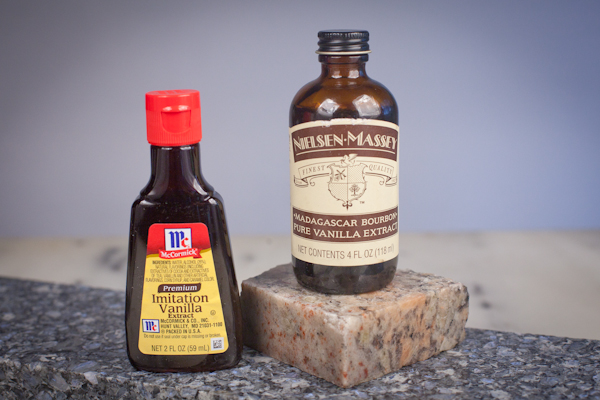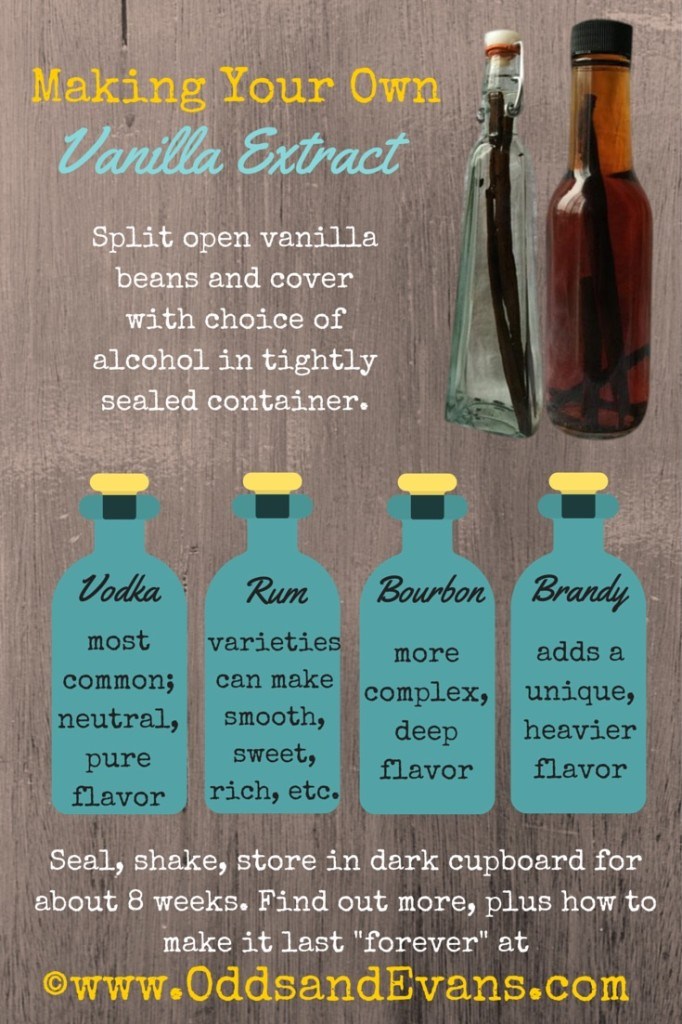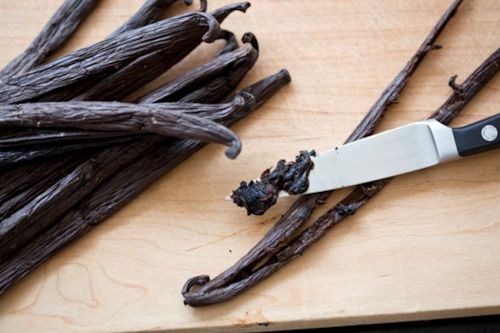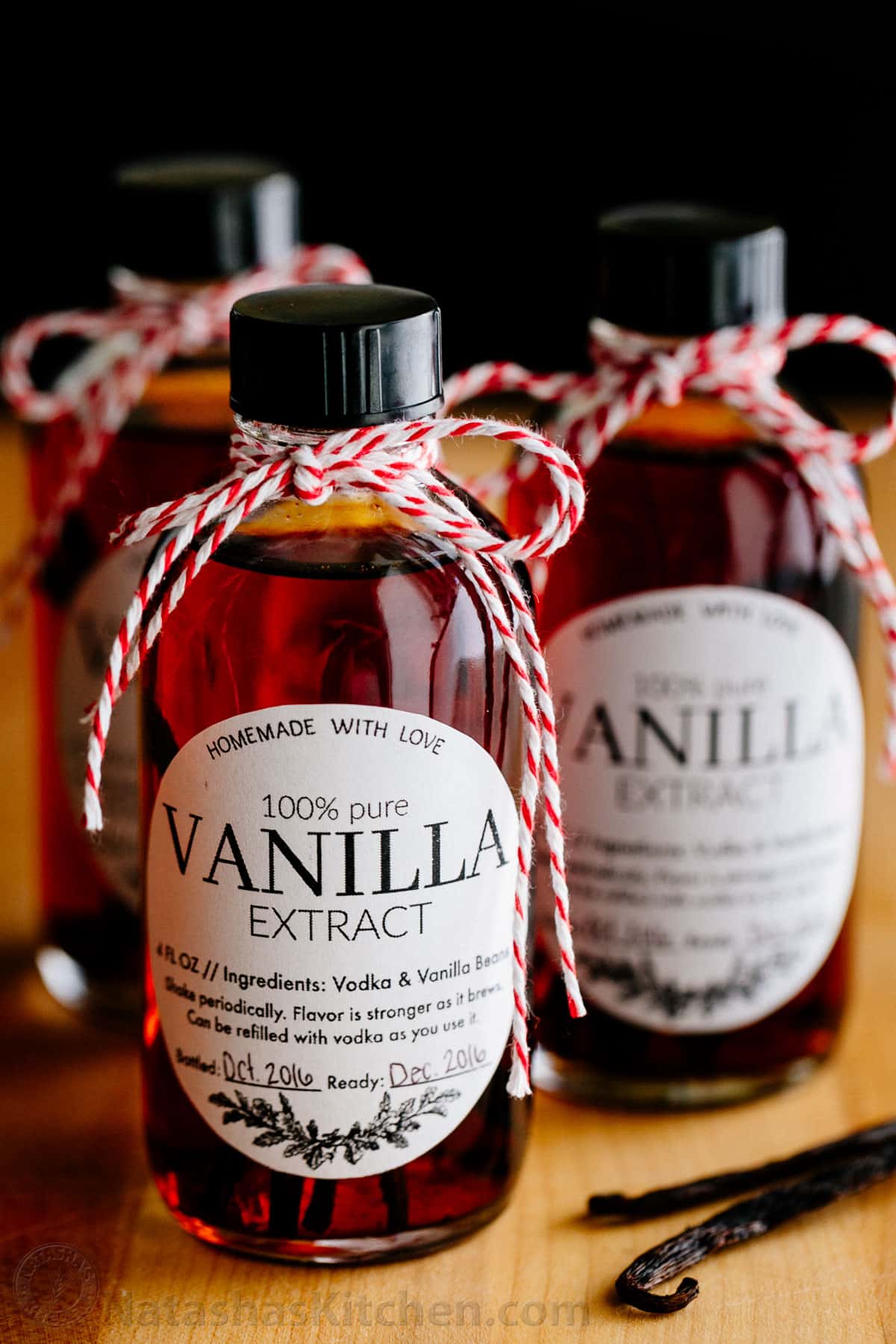Here’s the SUPER Easy Way to Make Vanilla Extract at Home
A couple days ago I found myself at the grocery store in the baking aisle staring between REAL vanilla and IMITATION vanilla for far longer than I probably should have.
Should I buy the 97 cent bottle or the tiny bottle that costs $7.97?

Does it really make that much of a difference??
I always have used the real stuff the last several bottles I’ve purchased but this time the practical side of my brain grabbed the 97 cent bottle and said a little prayer that it would work well in my baked goods!
When I got home I decided to do a little research to find out if the quality of vanilla really matters so let’s find out, shall we?
According to friends at Better Homes and Gardens here’s what you need to know:
Pure Vanilla Extract vs. Imitation Vanilla
In oven-baked goods such as cakes and cookies, it’s almost impossible to taste the difference between the flavor of items prepared with imitation vanilla or pure vanilla extract. Basically, for baked goods, imitation vanilla will be fine.
In low-heat sweets, such as puddings, pastry creams, and icings, the taste difference is more noticeable. For best results, use pure vanilla extract for these treats and for frozen desserts.
Tips for Vanilla Extract
“When you open a bottle of vanilla, do not peel away the paper or plastic cover on the bottle after you remove the lid. Instead, poke a few holes or a small slit in it. You can measure more accurately and if the bottle turns over it will not spill out or leak in the cabinet.”
Homemade Vanilla
If you Google “homemade vanilla” you will see about a million different posts and recipes to make your own vanilla. Like many things, people are just raving about how making your own vanilla tastes the absolute best and once you try it you’ll never go back. The cool thing about it is that it is extremely inexpensive and easy! And apparently it can last forever. By doing it yourself you also have control of exactly what goes into it so you’re not buying pricey vanilla extract that might have unnecessary flavoring and corn syrup added. I haven’t tried this yet but plan to do so soon.
For most recipes all you need is a bottle of alcohol (the most common is vodka) and some vanilla beans. You can get different flavorings from using different bottles of alcohol.

Here’s how you do it.

1. Choose your type of vanilla bean. The “best variety” depends on your personal preference in flavor. Madagascar is the most popular type and Indian is a consistent favorite. Each type is slightly different:
Bourbon vanilla – mild, well-balanced
Madagascar vanilla – rich and creamy
Mexican vanilla – bold, dark, smokey
Indian vanilla – full, chocolate
Tahitian vanilla – floral, cherry-chocolate
Tonga vanilla – earthy, fig, raisin
You will need:
-
Choice of vodka, light rum, bourbon, or brandy (Cheap ingredients = cheap results. I go mid-price instead of college-price. The higher proof, the better…but at least 35% alcohol. Mommypotamus is the queen of which non-GMO brands to buy if you’re interested)
-
Clear glass container that seals tightly, tall preferably (stopper bottles are great, or mason jars. See tips below for another cool idea…)
-
Time/Patience/Love (free!)
Directions:
1. Use a knife to slice the length of the vanilla beans, stopping an inch before the end so it doesn’t truly split in half. No problem if it does, but you get a cleaner extract this way without the vanilla seeds floating in it.
2. Place the beans inside the bottle. You also may need to cut the size of any beans, depending on your container, because you want them fully covered in the next step.
3. Using a funnel if necessary, pour the liquor over the vanilla beans in the bottle until completely immersed. If a bean sticks out, it may get moldy since it’s not being preserved.
4. Seal your bottle tightly, shake, and place in a dark, cupboard for at least 6-8 weeks. You can shake again occasionally whenever you think about it. Four months produces the perfect vanilla extract, in my opinion. The alcohol smell will fade as the vanilla is extracted, but you will still smell a slight liquor scent just as you do with store-bought. If it still smells like a cocktail, it’s not ready.
How to Use, (perpetually or not):
After at least 6-8 weeks, your vanilla is extracted enough for use as you would use store-bought in any recipe. You can just use it up or give it as a gift, if you’d like. (Some people like to add sugar to it at this point).

The perpetual/continuous method of use? There are two different ways to do this…
1. If you use a tablespoon of your vanilla extract, refill the bottle with a tablespoon of your liquor. Vigorously shake and return to dark cupboard. I prefer this method. I like the idea of keeping the beans covered and having more time to re-extract into a robust body.
2. Wait until your homemade vanilla extract is becoming, maybe, half full, THEN top off with more liquor, shake, and allow to extract again. Some people do this because they have two batches on hand, so that one has time to replenish properly.
** EITHER WAY, you may want to add/replace a vanilla bean or two here or there. Maybe once or twice a year, just to keep subsequent batches fragrant and rich.
Cool Tips:
-
You could just place split vanilla beans RIGHT INTO the bottle of liquor. How easy is that for finding a container?! This will make a large batch of course, that you could pour into smaller bottles or use as gifts if you wanted. Just remember 4-5 whole vanilla beans per 1 cup or so of liquor, so do the math with the spirit bottle size. Thinking 16-20 total vanilla beans, maybe?
-
Play around with a flavored vodka or liquor! You could try a cherry vodka with Tahitian vanilla beans soon…cordial cherries, anyone?!
-
When you use a fresh vanilla bean in the kitchen sometime, you may as well add it into your homemade vanilla extract.
Have you ever made your own vanilla at home? What did you think of the results?
- www.bhg.com
- www.natashaskitchen.com
- www.thekitchenwhisperer.net
- www.oddsandevans.com
 Mary Richardson
Mary Richardson
Weekly Newsletter Contributor since 2014
Email the author! mary@dvo.com
